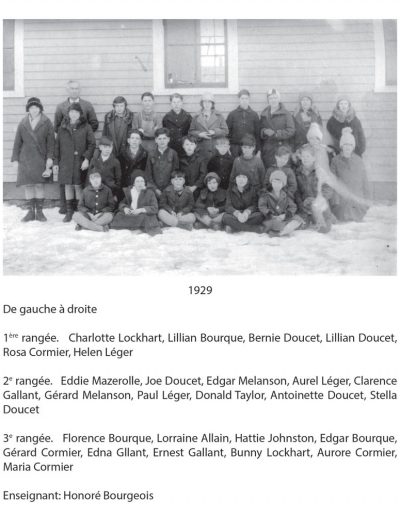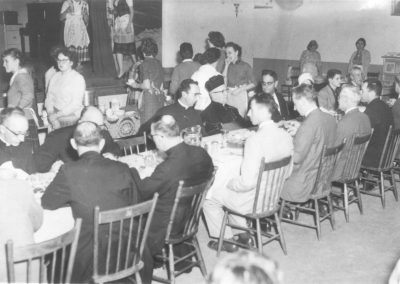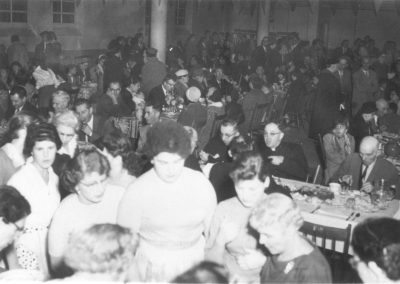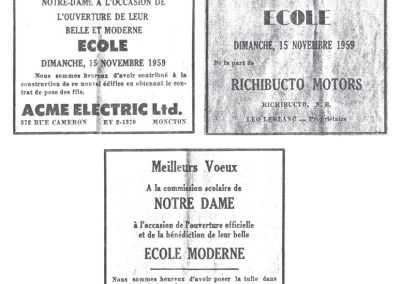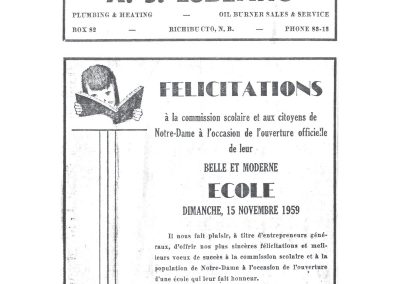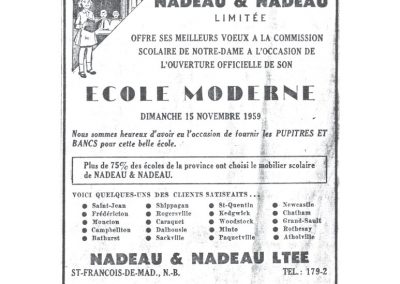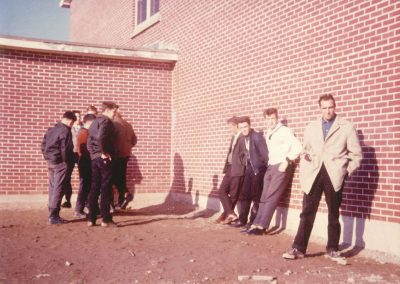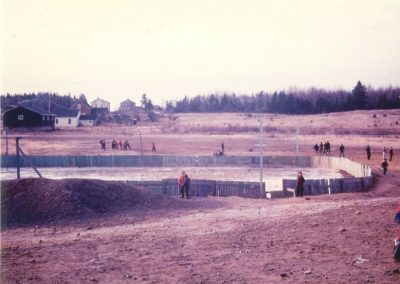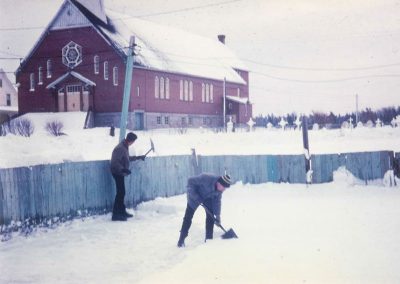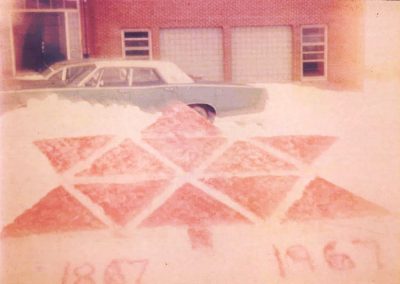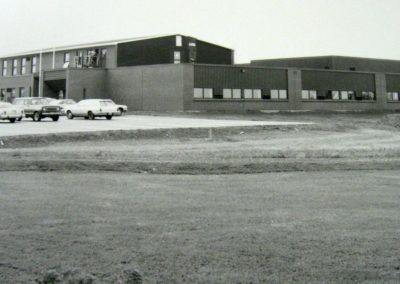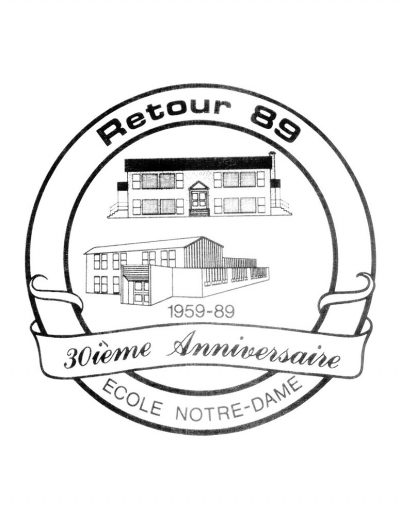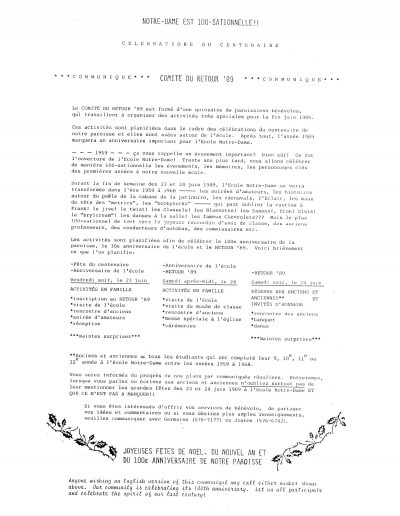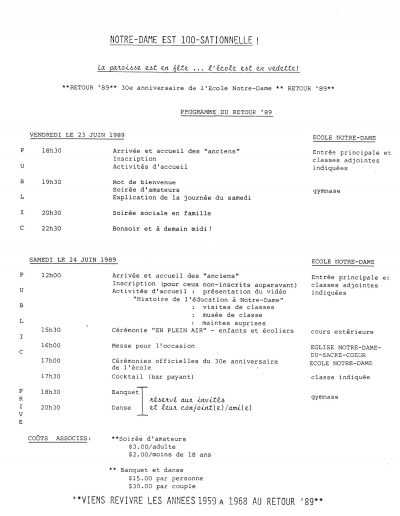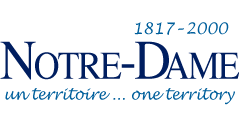Schools in Notre-Dame
Education was obviously important to the residents of Notre-Dame. Many settlements had their schools until the 1960s.
A new direction in schooling kids was pursued after the two-room school was destroyed by fire in January 1959. The school board quickly moved to build a large modern school in the centre of the village, across from the catholic church. And in just ten months, the new École Centrale was officially opened, in November 1959 to serve children from all corners of the community. The school was made bigger in 1982.
1826
Dundas was created from Wellington Parish, and it covered a large territory on the southern belt of Kent County. Communities such as Cocagne, Grande-Digue, Notre-Dame, Saint-Antoine, Goudalie, etc. were all part of the civil Parish of Dundas.
The Parish had a say in local governance and a responsibility to administer services such as schools. A local committee hired teachers, maintained the school infrastructure and grounds in good order, etc. As local schools were built, the district assigned them a number. For example, the district of Guéguen was designated as District Dundas 4.
Early 1830s
Basile Goguen is believed to be the first settler in Guéguen. He was followed by Thomas Goguen, Hubert LeBlanc, and Raphaël Richard, all from Memramcook. As well, Aimé Langis (Rimouski) moved to Guéguen after two relatives came to teach at the Cocagne North River School or l’École de Guéguen.
About 1841
The first school built was a log cabin used to teach children of the first settlers. It was located across the road from present day Notre-Dame Express store. The small school would be replaced in 1906 with a new two room school built one mile down the road, towards the mill.
About 1875
A school was built in Whites Settlement.
1875
A school was built in Guéguen and known as Cocagne River North, Parish of Dundas, NB. Its name would change again in 1911.
1879
The Cocagne River North School, which was built in 1875, opened in 1879. Located at the corner of Murray Road and Route 535, it served the children of the immediate area.
Abt 1880
Two schools were built: a French school in LeBlancville which remained open until 1946 and an English school in MacDougall Settlement which remained open until 1958.
1887
A school inspector reports that John Léger was teaching 38 students from grades one to eight at the Whites Settlement School. Magloire Cormier was the school secretary. In 1904, this school remained part of District 11, Dundas and Wellington. At one point, schoolteacher Honoré (Henry) Bourgeois had 42 students including Léo B. LeBlanc who became a famous painter.
1894
The first French school opened in MacDougall Settlement. It was located between the Elisban Gagnon store and the train tracks. Apparently, the school was burnt down following a dispute. A second and a third were built consecutively at the corner of Whites Settlement and MacDougall Settlement Road. In 1959, the MacDougall School was closed, and students were transferred to the new l’École Centrale de Notre-Dame, located across the road from the Catholic Church.
1903
The inspector, who visited the Cocagne River North School in Guéguen, found it unacceptable that lone teacher of eight grades, Hélène Bourque, had 82 students. He gave the district of Dundas an ultimatum to either expand or close the school. In 1911, its name changed to “École de Guéguen”.
1906
A second school was built in Notre-Dame, known as École de Dundas. This two-room school was located ½ mile down the road from the Catholic Church and served the community well until being destroyed by fire January 14, 1959. In ten months, a new larger school was built and opened to students grades 1 to 12, coming from every corner of the community. École Centrale de Notre-Dame.
Note: In the 1900s, schoolteachers were hired by local parent committees. Teachers lived “room and board” in the vicinity of the school. Inspectors were hired by Dundas Parish administrators who regularly visited school and wrote detailed reports which were influential and brought about change.
1911
The Cocagne River North school located in Guéguen changed its name to École de Guéguen.
1939
On November 13, 1939, inaugural classes at the École d’Agriculture at Université St-Joseph (Memramcook) started with 34 students. Classes were organized in six-week semesters and ran until May 1940. The first semester finished in December 1939 and the closing remarks were made by Napoléon Bourque. In 1964, he would become postmaster of the Notre-Dame Post Office.
1945
A new school was built in LeBlancville and it remained open until 1966.
1946
A new school was built in Dufourville and it remained open until about 1966.
1949-50
The first Whites Settlement school was replaced with the building of a new school. It was under the purview of Notre-Dame and remained open for about 15 years. With changes in school districts, students at Whites Settlement school were transferred to Cocagne.
1958
The English school at MacDougall Settlement closed and students were transferred to Scotch Settlement school which served both communities until 1963.
1958
Notre-Dame was made up of 7 different school districts: Upper Guéguen, Hays, Alexandrina, LeBlancville, Dufourville, MacDougall Settlement and Notre-Dame. A few years back, the Whites Settlement district had joined Cocagne. The school board was responsible for school maintenance and repair as well as for the hiring of teachers, heating and other expenses, paid for by local taxes.
1959
On January 14, 1959, the two-room wooden schoolhouse École de Dundas was destroyed by fire. Classes are held in the parish hall and in the church basement. Ten short months later, a new two storey brick school was officially opened on November 14. L’École Centrale de Notre-Dame continues to cater to francophone students from the four corners of the community. Today, it is known as École Notre-Dame. First principal was Roméo Robichaud, followed by Gérald Aucoin who remained for many years. President of the School Board was Ernest Gallant.
1959
The school at Village des Poirier/Poirier Office closed and students were transferred to École Centrale de Notre-Dame.
1959
The school at Hays closed. Little is known about it.
early 1960
The school at Guéguen closed.
Spring 1962
The first graduation at l’École Centrale de Notre-Dame had only one graduate, Claudette Gallant.
1963
English students from MacDougall Settlement and Scotch Settlement attended a new school in Irishtown, the Mountain View Consolidated School.
1963
On December 16, 1963, Bernice Gallant become the first Notre-Dame correspondent to the Acadian daily newspaper l’Évangeline.
1966
The school at LeBlancville closed. Shortly afterwards, the school at Dufourville also closed.
1966
The sisters Edith Robichaud and Stella Roach (Sisters of the Notre-Dame congregation, cn-d) arrived to found a convent. Followed by two other nuns, the convent of four sisters was established and quickly became an important source of support. The sisters served this community until the fall of 2007. The last nuns to leave were Sister Edith who moved to the convent of Saint-Louis, NB and eventually joined Sister Stella at Accueil Marguerite Bourgeoy in Quebec. Their contribution to the quality of life of the parish is immense and immeasurable.
1967/1968
This is the last school year for students between grades 9 and 12 to attend l’École Centrale de Notre-Dame and thus, the last graduating class. Afterwards, high school students attended the high school in Bouctouche.
1968
The last high school graduation in Notre-Dame was held in June 1968. Graduates were Omer Babineau, Robert Babineau, Roberte Cormier, Valmond Cormier, Claudine LeBlanc, Fernande LeBlanc, Francis LeBlanc and Carol Léger. Sadly missing was Josette Doucet who died in a horrific car accident on April 21, 1966 and involved four youth, two brothers and a brother-sister pair. Three people died that day, Josette Doucet, her brother Gérald, and her new boyfriend Victor Langis. It was a time of great sorrow for the families and the community which mourned their passing for many years.
1982
École Notre-Dame expanded under the leadership of Rose-Marie Babineau and other volunteers. A new gym, cafeteria, offices, and classrooms were added.
1989
L’École Notre-Dame celebrated its 30th anniversary with the return of former students, teachers and administrators during a weekend of activities. Many traveled from far and wide for the reunion which was a great success.








